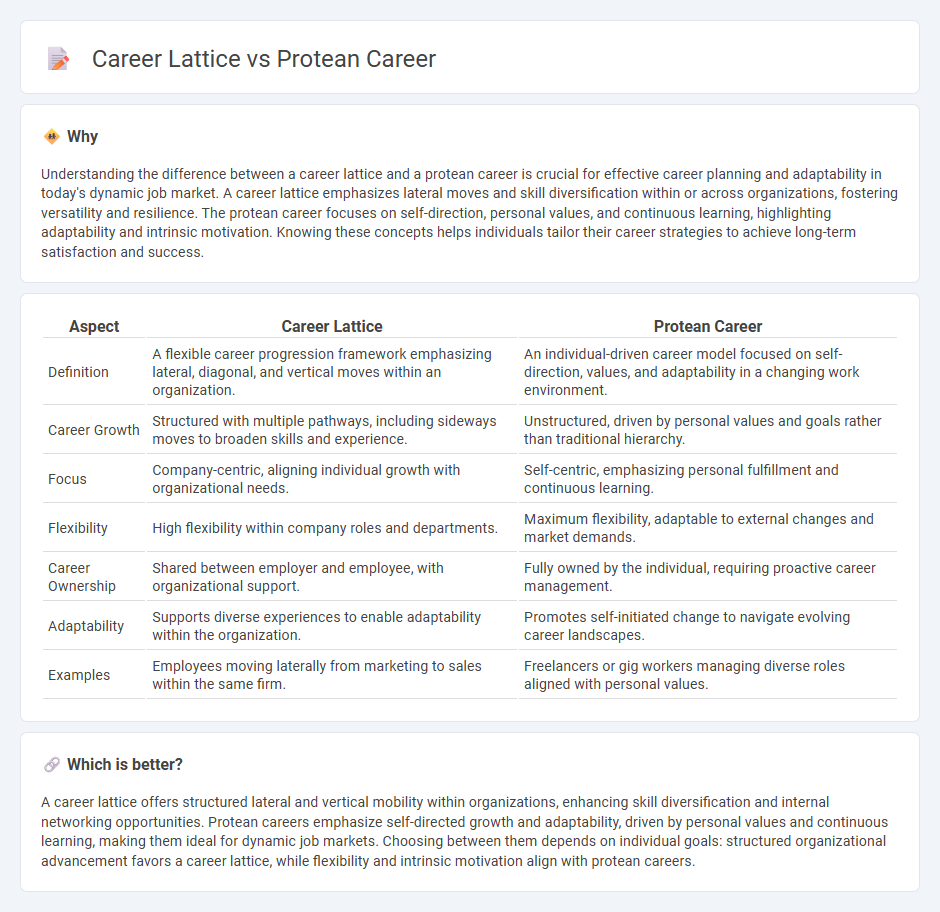
Career lattice models emphasize lateral and diagonal job moves to develop skills and broaden experience, promoting adaptability within organizations. Protean careers focus on self-directed growth, personal values, and continuous learning, driven by individual goals rather than organizational structures. Explore how these career frameworks influence employment strategies and career development pathways.
Why it is important
Understanding the difference between a career lattice and a protean career is crucial for effective career planning and adaptability in today's dynamic job market. A career lattice emphasizes lateral moves and skill diversification within or across organizations, fostering versatility and resilience. The protean career focuses on self-direction, personal values, and continuous learning, highlighting adaptability and intrinsic motivation. Knowing these concepts helps individuals tailor their career strategies to achieve long-term satisfaction and success.
Comparison Table
| Aspect | Career Lattice | Protean Career |
|---|---|---|
| Definition | A flexible career progression framework emphasizing lateral, diagonal, and vertical moves within an organization. | An individual-driven career model focused on self-direction, values, and adaptability in a changing work environment. |
| Career Growth | Structured with multiple pathways, including sideways moves to broaden skills and experience. | Unstructured, driven by personal values and goals rather than traditional hierarchy. |
| Focus | Company-centric, aligning individual growth with organizational needs. | Self-centric, emphasizing personal fulfillment and continuous learning. |
| Flexibility | High flexibility within company roles and departments. | Maximum flexibility, adaptable to external changes and market demands. |
| Career Ownership | Shared between employer and employee, with organizational support. | Fully owned by the individual, requiring proactive career management. |
| Adaptability | Supports diverse experiences to enable adaptability within the organization. | Promotes self-initiated change to navigate evolving career landscapes. |
| Examples | Employees moving laterally from marketing to sales within the same firm. | Freelancers or gig workers managing diverse roles aligned with personal values. |
Which is better?
A career lattice offers structured lateral and vertical mobility within organizations, enhancing skill diversification and internal networking opportunities. Protean careers emphasize self-directed growth and adaptability, driven by personal values and continuous learning, making them ideal for dynamic job markets. Choosing between them depends on individual goals: structured organizational advancement favors a career lattice, while flexibility and intrinsic motivation align with protean careers.
Connection
Career lattice models emphasize multidirectional movement within organizations, fostering skill development and adaptability essential for protean career management. Protean careers prioritize self-directed growth and personal values, aligning with the career lattice's flexible progression paths. Together, they support dynamic employment strategies that enhance individual agency and resilience in evolving job markets.
Key Terms
Self-direction
A protean career emphasizes self-direction through personal values, adaptability, and continuous learning, empowering individuals to shape their own professional paths without relying on traditional organizational structures. In contrast, a career lattice encourages lateral and non-linear movements within or across organizations, fostering self-direction by expanding skill sets and networks beyond hierarchical progression. Explore deeper insights on how self-directed career models transform modern professional development.
Flexibility
Protean careers emphasize self-directed growth and adaptability, empowering individuals to navigate diverse job roles based on personal values and evolving skills. Career lattices promote lateral and diagonal moves within an organization, fostering flexibility through varied experiences and cross-functional expertise. Discover how embracing these flexible career models can enhance your professional development and job satisfaction.
Non-linear progression
Protean career emphasizes self-directed, values-driven growth with adaptability as a core attribute, allowing professionals to navigate non-linear progression based on personal fulfillment and evolving goals. Career lattice involves lateral moves, skill diversification, and varied experiences across roles and departments, promoting broader competencies rather than traditional upward advancement. Explore further to understand how each model supports dynamic, non-linear career paths tailored to modern workforce demands.
Source and External Links
Protean Careers at Work: Self-Direction and Values - A protean career is characterized by self-direction and a focus on personal values, emphasizing identity awareness, adaptability, and agency in pursuit of psychological success, with benefits for both individuals and organizations.
Protean Career - Douglas T. Hall - Introduced by Douglas T. Hall, the protean career concept describes how workers increasingly manage their careers individually rather than through organizational loyalty, adapting to economic and technological changes in a volatile job market.
Protean Careers of the 21st Century - Hall's foundational work defines protean careers as self-driven, flexible career paths that prioritize personal values and adaptability over traditional organizational commitments.
 dowidth.com
dowidth.com